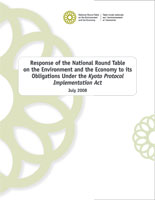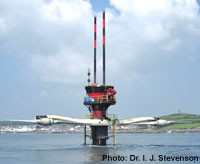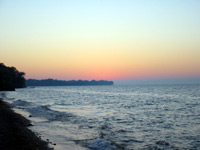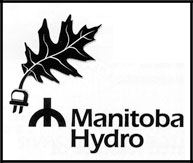
News |
- Canada's Air Pollution Death Toll Rising
- Generation Y Green Shoppers
- Water Treatment Plant Harmful to Lake Winnipeg
- Canada Still Overestimating GHG Reductions: NRTEE
- First Tidal Turbine - UK Energy Source
- 30% Solution For Energy Efficiency
- Invasive Species Mean Huge Economic Risk
- WCI Releases Draft Cap and Trade Framework
- Green Power? Manitoba Hydro Imports Dirty Energy
- Dehcho Share Park Advice with Misipawistik Cree
- 'New' Interprovincial Wilderness Area Announced
- First Nation Action Could Jeopardize Tar Sands
| Canada's Air Pollution Death Toll Rising | 26 August 08 |
 More and more Canadians will die from heart and lung conditions caused by breathing dirty air. The Canadian Medical Association has released a report linking negative impacts of air pollution on Canadians' health. More and more Canadians will die from heart and lung conditions caused by breathing dirty air. The Canadian Medical Association has released a report linking negative impacts of air pollution on Canadians' health.In 2008, 21,000 Canadians will die from the effects of air pollution. The CMA report "No Breathing Room: National Illness Costs of Air Pollution" suggests in just over two decades, 700,000 Canadians will die prematurely due to air pollution. Calculated according to the expected increase in concentration of ozone and particulate matter, the annual death toll is expected to rise 83 percent to 39,000 deaths a year by 2031. Short-term exposure to air pollution thickens the blood, and can cause heart attacks and strokes. Prolonged exposure to air pollution damages the muscle cells in the arteries of the heart, casing them to harden, said Ted Boadway, the association's technical adviser on health and the environment. Increasing emergency and doctor's office visits are expected to strain the health system, with costs in medical expenses and lost productivity, rising to $250 billion by the year 2031 if no improvements are made. View Canadian Medical Association - What is air pollution costing you?View August 2008 CMA, No Breathing Room: National Illness Costs of Air Pollution (PDF) View August 13, 2008 Canadian Medical Association article View August 13, 2008 Canadian Press article View August 25, 2008 The Intelligencer article View August 17, 2008 The Star article View August 13, 2008 CBC article Sources: Canadian Medical Association, Canadian Press, The Star, CBC, The Intelligencer |
|
 Print version Print version |
Top |
| Generation Y Green Shoppers | 26 August 08 |
 A survey of hip and trendy Americans has picked the top 15 brands favored for being environmentally conscious. A survey of hip and trendy Americans has picked the top 15 brands favored for being environmentally conscious. San Francisco-based marketing expert Outlaw Consulting has released the 2008 Green Brands Index. Surveyed Generation Y, aged 21-29 years, admit they do not always shop 'green' but ecological factors are important in categories like food, beauty and homecare. "Our aim was to discover which companies are going beyond the niche market of hard-core 'greenies' and winning over the more broadly influential members of this generation," said Barbara Bylenga, Outlaw Consultation founder and chief strategist. The top 15 companies are seen as trailblazers, being the first in their category to promote an eco-friendly alternative. Companies favored by Generation Y include Whole Foods, Google, Toyota, Ikea, Starbucks, Apple, and Method. View August 1, 2008 Corporate Responsibility Newswire articleVisit Outlaw Consulting View The Outlaw Newsletter - Issue 06 "The Green Issue" View July 30, 2008 Market Watch article Sources: Corporate Responsibility Newswire, Outlaw Consulting, Market Watch |
|
 Print version Print version |
Top |
| Water Treatment Plant Harmful to Lake Winnipeg | 20 August 08 |
 Scientific research disputes the need for a costly sewage treatment plant scheduled for Winnipeg. The proposed $10 to $50 million plant will include a biological nutrient removal process to strip effluent of nitrogen and phosphorus. Scientific research disputes the need for a costly sewage treatment plant scheduled for Winnipeg. The proposed $10 to $50 million plant will include a biological nutrient removal process to strip effluent of nitrogen and phosphorus. After a 37-year experiment, University of Alberta scientist David Schindler says there is no point removing nitrogen from the Lake Winnipeg watershed when phosphorus is the key pollutant causing potentially deadly blue-green algae blooms. Schindler's research compiled from the Experimental Lakes Area east of Kenora, Ontario suggests nitrogen removal will fail to control blue-green algae blooms and will in fact encourage growth. Lake Winnipeg Stewardship Board recommends reducing phosphorus concentration to 1mg/L and removing nitrogen only if necessary. Water and sewage bills are expected to double by the middle of next decade and Winnipeggers, politicians and scientists are questioning the logic of a costly nitrogen removal process. Schindler recommends treatment should focus on phosphorus removal to stop the degradation of Lake Winnipeg. View July 23, 2008 Winnipeg Free Press articleView CBC's A Sea of Troubles - Lake Winnipeg in Crisis View July 22, 2008 Victoria Times Colonist article View December 2006 Lake Winnipeg Stewardship Board, Reducing Nutrient Loading to Lake Winnipeg and its Watershed: Our Collective Responsibility and Commitment to Action (PDF) View City of Winnipeg Wastewater Upgrades Project Overview - North End Water Pollution Control Centre (NEWPCC) project upgrades Sources: Winnipeg Free Press, CBC, Victoria Times Colonist, Lake Winnipeg Stewardship Board, City of Winnipeg |
|
 Print version Print version |
Top |
| Canada Still Overestimating GHG Reductions: NRTEE | 20 August 08 |
 On August 1, 2008 Canada's National Round Table on the Environment and the Economy (NRTEE) released its evaluation of Environment Canada's latest greenhouse gas (GHG) reduction plan under the Kyoto Protocol Implementation Act. On August 1, 2008 Canada's National Round Table on the Environment and the Economy (NRTEE) released its evaluation of Environment Canada's latest greenhouse gas (GHG) reduction plan under the Kyoto Protocol Implementation Act.The NRTEE is obligated to undertake research and advise on the likelihood proposed policies and measures will achieve forecasted emissions reductions and whether these policies and measures enable Canada to meet its obligations under The Kyoto Protocol. As in 2007, the NRTEE concluded the federal government is overestimating emissions reductions as a result of plan initiatives during the Kyoto Protocol commitment period (2008-2012). NRTEE notes although emission reductions will occur as a result of the technology fund, most will occur outside the 2007-2012 period. The NRTEE report also suggests there is uncertainty as to whether the Regulatory Framework for Air Emissions will result in significant emissions reductions in the Kyoto timeframe. The Kyoto Protocol Implementation Act (KPIA), received Royal Assent June 2007; stipulates that each year the Government of Canada must prepare a Climate Change Plan describing measures and policies it enacted to meet Canada's obligations under the Kyoto Protocol. View July 2008 Response of the NRTEE to its Obligations Under the Kyoto Protocol Implementation Act or Download PDFView May 2008 Environment Canada report, A Climate Change Plan for the Purposes of the Kyoto Protocol Implementation Act (PDF) View Manitoba Wildlands' content on NRTEE's 2007 report on the federal government's greenhouse gas (GHG) reduction plan under the Kyoto Protocol Implementation Act Source: NRTEE |
|
 Print version Print version |
Top |
| First Tidal Turbine - UK Energy Source | 20 August 08 |
 The world's first commercial-scale tidal turbine is hooked into UK's national grid. At full power an estimated 1,200 kW of energy will supply about 1000 homes and help reach the UK government's target of 15% clean energy by 2020. The world's first commercial-scale tidal turbine is hooked into UK's national grid. At full power an estimated 1,200 kW of energy will supply about 1000 homes and help reach the UK government's target of 15% clean energy by 2020.Developed by British tidal energy company, Marine Current Turbines (MTC), the 'SeaGen' turbine works like an underwater windmill. More predictable than wind or solar power, the UK government has set up a £42 million Marine Renewables Deployment Fund to help firms develop these projects. Situated in Strangford Lough in Northern Ireland, gravitational attraction of the moon creates some of the world's fastest tidal flows at speeds of up to 8 knots. A farm of turbines off the coast of Anglesey, north Wales, is expected around 2011/2012. "Marine power has the potential to play an important role in helping us meet our challenging targets for a massive increase in the amount of energy generated from renewables," says secretary of state for business, John Hutton. Strangford is a breeding ground for common seals but MTC says the turbines are unlikely to pose a threat to marine wildlife with rotors turning no more than 10 to 15 revolutions per minute. Turbines are also less damaging than constructing dams to harness tidal energy. View August 17, 2008 Times Online articleView July 17, 2008 Guardian article View August 15, 2008 Eco Worldly article View July 17, 2008 Clean Technica article View July 18, 2008 Tree Hugger article Sources: Times Online, Guardian, Eco Worldly, Clean Technica, Tree Hugger |
|
 Print version Print version |
Top |
| 30% Solution For Energy Efficiency | 20 August 08 |
 Homes in the United States use 20 percent of the nation's energy and account for one-fifth of U.S. greenhouse gas emissions. Energy Efficient Codes Coalition (EECC) has launched "The 30% Solution" campaign to raise the energy efficiency code for a new home by 30 percent. Homes in the United States use 20 percent of the nation's energy and account for one-fifth of U.S. greenhouse gas emissions. Energy Efficient Codes Coalition (EECC) has launched "The 30% Solution" campaign to raise the energy efficiency code for a new home by 30 percent.The EECC is a coalition of energy efficiency advocates with celebrated support from the International Council for Local Environmental Initiatives (ICLEI), the U.S. Conference of Mayors and Sierra Club US Cool Cities program. On September 21-22 in Minneapolis, the International Codes Coalition (ICC) members will vote on the 30% Solution, a proposed amendment to the International Energy Conservation Code. If approved the 30% Solution would save the U.S. an estimated $88 billion in energy costs and reduce CO2 by 464 million metric tons by 2030. William Fay, coordinator of the CCEE says it "may be America's most significant energy, environmental and climate policy vote of 2008." Visit Energy Efficiency Codes Coalition (EECC) - The Thirty Percent SolutionView August 7, 2008 Sierra Club US blog View July 2, 2008 Thirty percent solution article View June 23, 2008 Thirty percent solution article View July 25, 2008 Climate and Energy blog View ICLEI, The 30% Solution: How you can help Sources: EECC, Sierra Club, Climate & Energy Blog, ICLEI |
|
 Print version Print version |
Top |
| Invasive Species Mean Huge Economic Risk | 13 August 08 |
 Zebra mussels, round goby, Eurasian ruffe and other invasive species transported to The Great Lakes by ships are costing the United States about $200 million a year. Similar economic impacts are estimated for Canada. Zebra mussels, round goby, Eurasian ruffe and other invasive species transported to The Great Lakes by ships are costing the United States about $200 million a year. Similar economic impacts are estimated for Canada.The St Lawrence Seaway opened the Great Lakes to international maritime trade in 1959. Since then the number of invasive species has risen, causing native fish populations to be displaced and food chains disrupted. American scientists have linked impacts of invasive species to economic indicators for sport and commercial fishing, wildlife viewing, and use of water. According to the the Universities of Notre Dame and Wyoming study, annual loss to sport fishing alone is more than $123 million. The study says 57 of the 84 invasive spices were transported to the Great Lakes in ballast water of ships. A number of regulations are already in place for handling ballast water but discrepancies between Canadian and U.S. requirements makes monitoring difficult. View July 17, 2008 CBC articleView July 17, 2008 The Guardian article View August 12, 2008 Canada.com article View July 23, 2008 New York State Attorney General press release View August 12, 2008 Petoskey News-Review article View July 17, 2008 Science Daily article View July 7, 2008 National Public Radio article Visit U.S. EPA Invasive Species - Great Lakes Pollution Prevention and Toxics Reduction Source: CBC, Guardian, National Public Radio, Canada.com, New York State Attorney General, Science Daily, US EPA |
|
 Print version Print version |
Top |
| WCI Releases Draft Cap and Trade Framework | 11 August 08 |
 The Western Climate Initiative released its draft design framework for a broad cap-and-trade program to reduce greenhouse-gas emissions July 23, 2008. Membership in WCI includes: Manitoba, British Columbia, Quebec, Ontario, and several US state governments. The Western Climate Initiative released its draft design framework for a broad cap-and-trade program to reduce greenhouse-gas emissions July 23, 2008. Membership in WCI includes: Manitoba, British Columbia, Quebec, Ontario, and several US state governments.The cap would force polluting companies to pay for emissions they created and would apply to all companies and sites emitting more than 25,000 tonnes of "carbon dioxide equivalents" per year. Climate advocates are supportive of the intent and overall direction of the WCI, but were cautiously critical of the draft cap-and-trade recommendations. They expressed disappointment at initial caps being set at business-as-usual levels and that the framework wouldn't bring large polluters into the system until 2012, and even 2015 for some. WWF Canada, the Pembina Institute and the David Suzuki Foundation say that the WCI partners should:
The plan is open for public review and comments until mid-August and is scheduled to be finalized September 2008. View July 23, 2008 Draft Design Recommendations for the WCI cap-and-trade program (PDF)View July 24, 2008 Globe and Mail article View July 24, 2008 Vancouver Sun article View July 29, 2008 Toronto Star article View July 28, 2008 WWF Canada press release View July 2008 David Suzuki Foundation/Pembina Institute backgrouner, Western Climate Initiative San Diego Meeting July 29, 2008 (PDF) View more information on the WCI from Manitoba Wildlands View July 2008 WeCAN comments on the WCI draft: WeCAN comments with points for all WCI Subcommittees (PDF) WeCAN comments on Forests, Land Use and Land Use Change (PDF) Sources: Toronto Star, WWF Canada, David Suzuki Foundation, Pembina Institute, Globe and Mail, Vancouver Sun |
|
 Print version Print version |
Top |
| Green Power? Manitoba Hydro Imports Dirty Energy | 11 August 08 |
 It's a little-known fact that Manitoba Hydro imports power from the US during nighttime hours, especially in the winter. Some of that power comes from nuclear plants, but most comes from coal-fired generators - which emit harmful GHGs. It's a little-known fact that Manitoba Hydro imports power from the US during nighttime hours, especially in the winter. Some of that power comes from nuclear plants, but most comes from coal-fired generators - which emit harmful GHGs.In the 2007-08 year, Hydro imported 600 million kilowatt hours of US power, about 355 mega tonnes of greenhouse gas emissions. Manitoba Hydro argues that importing power overnight helps keep Manitoba's rates among the lowest. And Hydro can sell 'surplus' power back to the United States during the day, keeping states such as Minnesota and Wisconsin from firing up more coal generators to meet peak daytime needs. "If Manitoba is serious about meeting Kyoto targets, why don't we use our own power to meet domestic energy needs? If Manitobans are consuming fossil fuel based power, is this reflected in Manitoba's calculations of greenhouse gas emissions? These are the kind of questions that must be answered in Manitoba's intended new Energy Plan," said Gaile Whelan Enns, of Manitoba Wildlands. The Manitoba government intends to work on a province-wide Engery Plan during fall 2008. View August 2, 2008 Winnipeg Free Press articleView 57th Annual Report of the Manitoba Hydro-Electric Board for the Year Ended March 31, 2008 (see page 9 for import statistics) (PDF) Sources: Winnipeg Free Press, Manitoba Hydro |
|
 Print version Print version |
Top |
| Dehcho Share Park Advice with Misipawistik Cree | 07 August 08 |
 In July 2008, delegates from Misipawistik Cree Nation in Grand Rapids, Manitoba visited the Dehcho First Nations (DFN). The Manitoba Cree were seeking information about how Parks Canada and First Nations work together to establish national parks. In July 2008, delegates from Misipawistik Cree Nation in Grand Rapids, Manitoba visited the Dehcho First Nations (DFN). The Manitoba Cree were seeking information about how Parks Canada and First Nations work together to establish national parks.Parks Canada and Manitoba are proposing to establish a national park within Misipawistik's traditional lands to protect and represent the Lake Winnipeg Lowlands. The Misipawistik Cree's knowledge of parks establishment is drawn from the 1920s and 30s when Riding Mountain National Park was established. (First Nation people were forcibly evicted.) Parks Canada officials indicated national parks are no longer established against the will of First Nations, and sponsored the fact-finding trip. The trip allowed Elders and Council members to evaluate Parks Canada methods. Emphasis on exercise of traditional rights in national parks continued through the tour. The fact-finding trips included visits to Nahanni National Park Reserve and Wood Buffalo National Park, as well as Wapusk National Park in Manitoba, Torngat Mountains National Park in Labrador, and Gwaii Haanas National Park Reserve in B.C. View July 24, 2008 Northern News Services articleView April 2008 Parks Canada Agency publication, Words to Action (see page 23) (PDF) View October 2007 Wapusk National Park Management Plan (PDF) View Manitoba Wildlands Map of Chitek Lake Park Reserve and Lowlands National Park Source: Northern News Services, Manitoba Wildlands |
|
 Print version Print version |
Top |
| 'New' Interprovincial Wilderness Area Announced | 07 August 08 |
 The governments of Ontario and Manitoba announced establishment of an interprovincial wilderness area on July 30, 2008. The governments of Ontario and Manitoba announced establishment of an interprovincial wilderness area on July 30, 2008.The region covers 9,400 square kilometres of land, plus existing parks and protected areas including Woodland Caribou Provincial Park and the Eagle-Snowshoe Conservation Reserve in Ontario, and Atikaki Wilderness Park and parts of Nopiming Provincial Park in Manitoba. Establishing and jointly managing the area is a step by government toward inscription of Eastside Manitoba and Ontario boreal forestlands as a UNESCO World Heritage Site. The announcement was criticized as being a bureaucratic arrangement that does not increase amount of protected land, and does little to prevent mining and logging or to protect woodland caribou. None of the region's First Nations were party to the announcement. "There's no new protected areas," said Janet Sumner, executive director of the Wildlands League. "They're basically saying, 'We have existing wilderness areas and we're going to talk to each other as we manage them.' " Eric Reder of the Wilderness Committee said if Manitoba was serious about protecting woodland caribou, it would have included new land under a new wilderness area, including where caribou calve in the northeast corner of Nopiming park. "That area remains at risk to logging despite a 1992 report stating it should be set aside from any development," he said. View July 30, 2008 Government of Manitoba press releaseView Manitoba Conservation page for Manitoba-Ontario Interprovincial Wilderness Area View a summary of the Manitoba-Ontario Interprovincial Wilderness Area (PDF) View July 31, 2008 Canadian Press article View July 31, 2008 Winnipeg Free Press article View more information about the Interprovincial Wilderness Area and the proposed Manitoba-Ontario World Heritage Site Sources: Government of Manitoba, Canadian Press, Winnipeg Free Press |
|
 Print version Print version |
Top |
| First Nation Action Could Jeopardize Tar Sands | 06 August 08 |
 Alberta Beaver Lake Cree and Victoria-based Aboriginal law expert Jack Woodward are moving forward with a legal challenge that could throw a huge wrench into Alberta's tar-sands. Alberta Beaver Lake Cree and Victoria-based Aboriginal law expert Jack Woodward are moving forward with a legal challenge that could throw a huge wrench into Alberta's tar-sands.The suit, filed May 2008, pits Beaver Lake Cree against governments of Canada and Alberta, and lays groundwork for a new legal regime governing resource extraction on traditional lands of Canada's First Nations. On May 14, 2008, the Beaver Lake Cree released their Kétuskéno Declaration, which asserts their role as caretakers of their traditional territories and initiates the legal action. The First Nation claims Alberta and Canada have infringed Beaver Lake's Treaty rights by approving oil and gas and other developments throughout the First Nation's traditional territory. Attached to the statement of claim is a schedule listing more than 15,000 asserted infringements of Beaver Lake's constitutionally protected rights. The court is asked to rule invalid government authorizations for thousands of petroleum projects in the First Nation' core territory. A victory in the courts would allow Beaver Lake Cree to demand higher levels of accommodation and consultation from government and industry on operations in their territory and could set a precedent for other bands to enforce similar demands on oil-sands projects. View July 28, 2008 Tyee.ca articleView May 14, 2008 Statement of Claim by Beaver Lake Cree Nation in the Alberta Court of Queens' Bench (PDF) View May 14, 2008 Beaver Lake Cree Nation Kétuskéno Declaration (PDF) View May 14, 2008 Beaver Lake Cree Nation press release (PDF) View November 24, 2005 Mikisew Cree Supreme Court of Canada decision (PDF) View November 20, 2007 Tsilhqot'in Nation British Columbia Supreme Court decision (PDF) Sources: The Tyee, Beaver Lake Cree Nation |
|
 Print version Print version |
Top |


 RSS Feeds:
RSS Feeds: